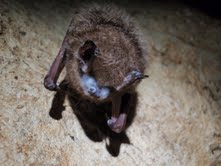|
Contact: Carol Borneman, (606) 248-2817, extension 1070

NPS photo White-nose syndrome (WNS), a condition deadly to bats, has now been confirmed at Cumberland Gap National Historical Park (NHP) according to Park Superintendent Mark Woods. Woods details that laboratory histopathology tests on three bats, from three of the park's more than 30 caves, tested positive for the disease; two of these bats also showed visible signs of WNS. White-nose syndrome is known to be transmitted primarily from bat to bat, but spores of Geomyces destructans, the fungus that causes white-nose syndrome, may be inadvertently carried between caves by humans on clothing, footwear, and caving gear. White-nose syndrome is not known to affect people, pets, or livestock but is harmful or lethal to hibernating bats, killing 90 percent or more of some species of bats in caves where the fungus has lasted for a year or longer, according to the U.S. Fish and Wildlife Service. White-nose syndrome was first detected in New York State in 2006 and has killed more than 5.5 million cave-dwelling bats in the eastern third of North America as it has spread south and west. The fungus that causes white-nose syndrome has been confirmed in 21 states; white-nose syndrome has been confirmed in 19 states. It has also been confirmed in four Canadian provinces. A map of the current spread of white-nose syndrome can be found at http://whitenosesyndrome.org/ resources/map. Decontamination procedures to prevent spread of the fungal spores by human beings were adopted more than three years ago as white-nose syndrome was decimating bat populations in the northeast. Cumberland Gap NHP implemented such procedures years ahead of any actual finding of white-nose syndrome in the park in an effort to delay its arrival and to be fully prepared should it appear. Visitors on Gap Cave tours were being interviewed before cave tours to see if they had items that had been in other caves or mines since 2006. If so, they were asked to leave those items out of the cave or if needed, their footwear was decontaminated before tours. Researchers working in park caves followed current national guidance for decontamination before and after their visits. Woods explains that "Ranger led tours of the park's Gap Cave, attended annually by almost 5000 visitors, will continue." Park staff has been working closely with the Virginia Department of Game and Inland Fisheries in cooperation with other federal and Virginia, Kentucky and Tennessee state agencies (while the park is located in these three states, most of the caves are located within the Virginia section of the park), universities, and other non-government organizations which have been monitoring the spread of the WNS fungus since first discovered in Bath County, Virginia in February 2009. Because the fungus grows at temperatures below 70oF, the hibernation season (November through March) is the best time of year to detect the growth on bats. This limits the survey areas to the mountainous regions of the state where bats hibernate in caves and mines. The Lower Powell Valley drainage was the last area in the state where WNS had not been detected. With the discovery of WNS at Cumberland Gap NHP, the disease has now been observed in all the major mountain drainages of the state. Virginia's focus is now on determining the impacts of WNS on the different cave bat species and determining if individuals can persist over time in the face of infection. Six species of cave-dwelling bats, including the endangered Indiana bat, are found at Cumberland Gap NHP. All six species are at risk from WNS. Three species of tree-dwelling bats are also found in the park. Some bats spend both the summer and winter at Cumberland Gap. However, other bats are much more mobile, wintering at the park but spending the summer in other areas or vice-versa. Bats play a crucial role in the environment. Bats are the only major predator of night-flying insects. A single big brown bat can eat between 3,000 and 7,000 mosquitos in a night, with large populations of bats consuming thousands of tons of potentially harmful forest and agricultural pests annually. "The mission of the National Park Service," spells out Woods "is to preserve natural treasures and to provide a way for people to enjoy them. Our response to challenges such as white-nose syndrome applies the best available science and research to find the proper balance between those roles, and a sustainable future for our parks." |
Last updated: April 14, 2015
